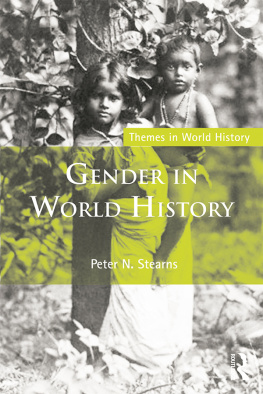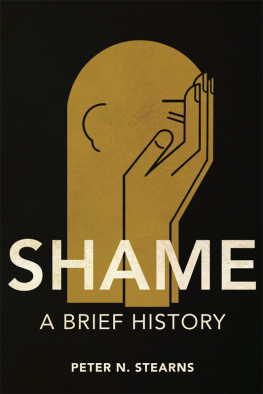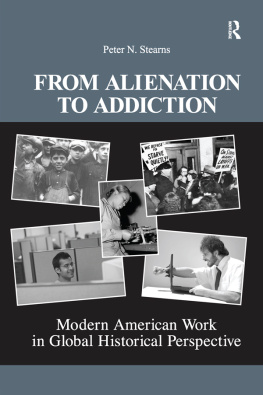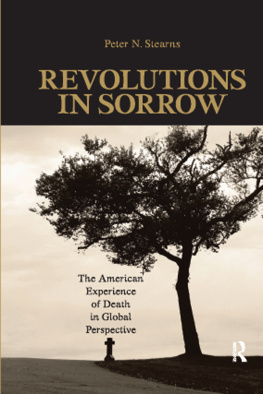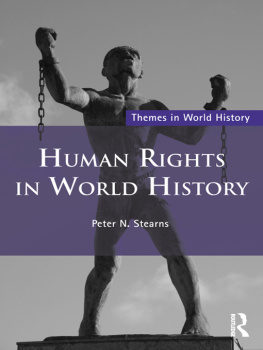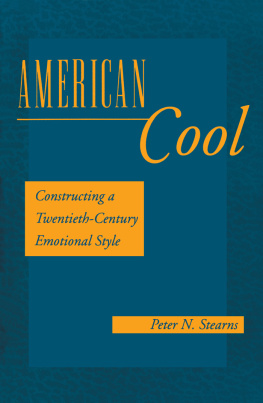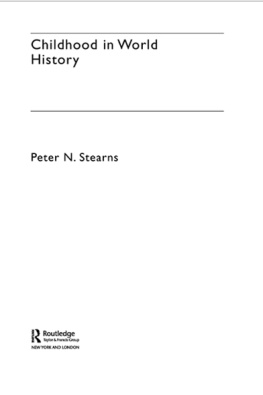Peter N. Stearns - Gender in World History
Here you can read online Peter N. Stearns - Gender in World History full text of the book (entire story) in english for free. Download pdf and epub, get meaning, cover and reviews about this ebook. City: New York, year: 2015, publisher: Taylor & Francis (CAM);Routledge, genre: Politics. Description of the work, (preface) as well as reviews are available. Best literature library LitArk.com created for fans of good reading and offers a wide selection of genres:
Romance novel
Science fiction
Adventure
Detective
Science
History
Home and family
Prose
Art
Politics
Computer
Non-fiction
Religion
Business
Children
Humor
Choose a favorite category and find really read worthwhile books. Enjoy immersion in the world of imagination, feel the emotions of the characters or learn something new for yourself, make an fascinating discovery.
- Book:Gender in World History
- Author:
- Publisher:Taylor & Francis (CAM);Routledge
- Genre:
- Year:2015
- City:New York
- Rating:4 / 5
- Favourites:Add to favourites
- Your mark:
- 80
- 1
- 2
- 3
- 4
- 5
Gender in World History: summary, description and annotation
We offer to read an annotation, description, summary or preface (depends on what the author of the book "Gender in World History" wrote himself). If you haven't found the necessary information about the book — write in the comments, we will try to find it.
Gender in World History — read online for free the complete book (whole text) full work
Below is the text of the book, divided by pages. System saving the place of the last page read, allows you to conveniently read the book "Gender in World History" online for free, without having to search again every time where you left off. Put a bookmark, and you can go to the page where you finished reading at any time.
Font size:
Interval:
Bookmark:
This edition published 2015
by Routledge
711 Third Avenue, New York, NY 10017
and by Routledge
2 Park Square, Milton Park, Abingdon, Oxon OX14 4RN
Routledge is an imprint of the Taylor & Francis Group, an informa business
2015 Taylor & Francis
The right of Peter N. Stearns to be identified as author of this work has been asserted by him in accordance with sections 77 and 78 of the Copyright, Designs and Patents Act 1988.
All rights reserved. No part of this book may be reprinted
or reproduced or utilized in any form or by any electronic, mechanical, or other means, now known or hereafter invented, including photocopying and recording, or in any information storage or retrieval system, without permission in writing from the publishers.
Trademark notice: Product or corporate names may be trademarks or registered trademarks and are used only for identification and explanation without intent to infringe.
First edition published 2001 by Routledge
Second edition published 2006 by Routledge
Library of Congress Cataloging-in-Publication Data
Stearns, Peter N.
Gender in world history / Peter N. Stearns. Third edition.
pages cm. (Themes in world history)
Includes index.
1. Sex roleHistory. 2. Man-woman relationshipsHistory.
3. Sex differencesHistory. I. Title.
HQ1075.S73 2015
305.309dc23
2014038854
ISBN: 978-1-138-85310-2 (hbk)
ISBN: 978-1-138-85311-9 (pbk)
ISBN: 978-1-315-72227-6 (ebk)
Typeset in Times New Roman
by Apex CoVantage, LLC

Series editor: Peter N. Stearns
The Themes in World History series offers focused treatment of a range of human experiences and institutions in the world history context. The purpose is to provide serious, if brief, discussions of important topics as additions to textbook coverage and document collections. The treatments will allow students to probe particular facets of the human story in greater depth than textbook coverage allows, and to gain a fuller sense of historians analytical methods and debates in the process. Each topic is handled over timeallowing discussions of changes and continuities. Each topic is assessed in terms of a range of different societies and religionsallowing comparisons of relevant similarities and differences. Each book in the series helps readers deal with world history in action, evaluating global contexts as they work through some of the key components of human society and human life.
Gender in World History
Peter N. Stearns
Consumerism in World History
The Global Transformation of Desire
Peter N. Stearns
Warfare in World History
Michael S. Neiberg
Disease and Medicine in World History
Sheldon Watts
Western Civilization in World History
Peter N. Stearns
The Indian Ocean in World History
Milo Kearney
Asian Democracy in World History
Alan T. Wood
Revolutions in World History
Michael D. Richards
Migration in World History
Patrick Manning
Sports in World History
David G. McComb
The United States in World History
Edward J. Davies, II
Food in World History
Jeffrey M. Pilcher
Childhood in World History
Peter N. Stearns
Religion in World History
John Super and Briane Turley
Poverty in World History
Steven M. Beaudoin
Premodern Travel in World History
Steven S. Gosch and Peter N. Stearns
Premodern Trade in World History
Richard L. Smith
Sexuality in World History
Peter N. Stearns
Globalization in World History
Peter N. Stearns
Jews and Judaism in World History
Howard N. Lupovitch
The Environment in World History
Stephen Mosley
Agriculture in World History
Mark B. Tauger
Science in World History
James Trefil
Alcohol in World History
Gina Hames
Human Rights in World History
Peter N. Stearns
Peace in World History
Peter N. Stearns
The Atlantic Slave Trade in World History
Jeremy Black
A collective look at key cases of international interchange that affected male female relationships invites three evaluations. All respond to the legitimate question: what happens when one moves from a set of good individual stories to an inquiry about broader patterns? The first evaluation, and it can be brief, involves the range of contacts itself. The second seeks generalizations about the results of contact on gender, and whether any patterns emerge. The third, looking at the historical cases sequentially, asks about any trends of change over time.
Using results on men and women as a vantage point on the nature of cultural interchange drives home key characteristics of interchange itself. World historians increasingly emphasize contact as one of the anchors of their ambitious subject, a means of linking individual societies to broader, sometimes global processes. The gender dimension illustrates how varied contacts can be. They range from casual, limited exchange to the complex results of introducing a new religion into an established cultural system. They can include interaction among relatively equal societies, but also virtual cultural compulsion, as in Western Europes approach to Native Americansand various possibilities in between the two extremes. Along with variety, the gender factor consistently suggests complexity; even the most overt cultural compulsion does not generate the expected or desired results.
Contacts also embrace unexpected tie-ins. The spread of Islam included interaction with other Middle Eastern practices such as veiling; Christianity often was linked with unusual Western definitions of family life and domesticity; international consumerism combines glitz and style with messages about womens distinctive obligations to beauty, a blend of seeming freedom and new compulsions. Interaction packages are untidy.
What role has cultural exchange played in confirming or changing mens and womens ideals and behaviors? Here, the examination of the kinds of contacts in world history that affected gender relations suggests several general points. The first, admittedly, is simply cautious: each case of contact is distinctive, the consequences often complex and hard to predict. There are no easy laws of history in this area. Thus contact may promote better conditions for women in relation to men, or the precise oppositeor, most commonly, some combination effect. Variation depends on the complexity of the outside influences but also on prior customs in the receiving society, which is why no two cases are exactly alike.
Variety shows in patterns of timing. Some contacts seem to affect mens and womens behaviors rather quickly; a case in point may be the impact of Buddhism on China, where women could use Buddhism as an outlet without disturbing fundamental gender relationships. Certainly contacts that involve compulsion, like the European entry to the Americas, can make an effect quickly, but some contacts work out only over prolonged periods, like the impact of Islam on parts of India. There are simply no clear regularities. Will some of the new contacts that developed in the twentieth-century world also vary in the time it takes to determine basic results?
Font size:
Interval:
Bookmark:
Similar books «Gender in World History»
Look at similar books to Gender in World History. We have selected literature similar in name and meaning in the hope of providing readers with more options to find new, interesting, not yet read works.
Discussion, reviews of the book Gender in World History and just readers' own opinions. Leave your comments, write what you think about the work, its meaning or the main characters. Specify what exactly you liked and what you didn't like, and why you think so.

